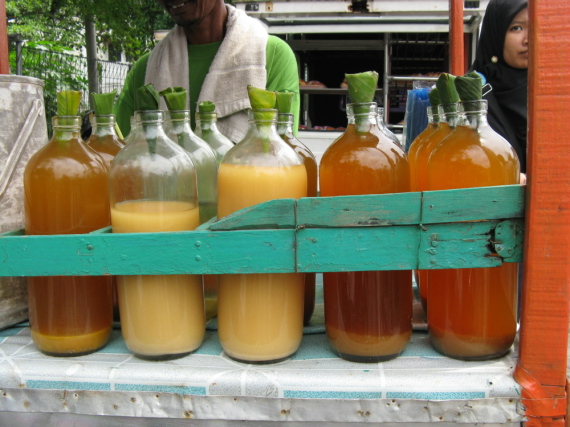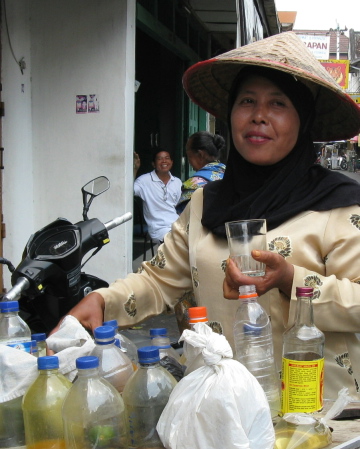Hans Pols
A jamu stand in Central JavaHans Pols |
Every morning across Java, women carry baskets on their backs filled with bottles containing liquid mixtures to sell on the street. These intriguing fluids, which the women prepare themselves, are known as jamu, and are traditional Indonesian herbal medicines. Traditional Indonesian healers define health in terms of a balance between the polarities of hot and cold, and dry and wet. If the human body becomes too hot, as is the case during fevers, cooling vegetables and herbs are prescribed. In a similar vein, colds are treated with spices, which heat up the body.
The jamu sellers may seem unassuming, but to many these women are walking, talking pharmacies. On their backs are possible remedies for just about everything from skin problems and rheumatic pain to sexual dysfunction. Other preparations claim to boost energy and concentration, reduce stress and enhance youth. There are even jamu concoctions that purport to have cosmetic effects. Jamu is also big business. In addition to these individual jamu sellers, a dozen industrial manufacturers (among them Nyonya Meneer, Jago, Air Mancur and Jamu Iboe) sell preparations in their own stores, in pharmacies and in small shops. There are now even exclusive jamu shops in upscale malls, targeting middle-class customers. The promotional material of the jamu industry often emphasises the ancient roots of Indonesian traditional herbal medicine and its historical links to the courts of Solo and Yogyakarta. Indeed, archaeological findings, including a number of relief carvings on the famous Borobudur temple in Central Java, indicate that herbs and spices have been used for medicinal purposes for thousands of years. Being located at the cross-roads of international trading routes, the Indonesian archipelago has a long history of contact with Chinese and Arab traders, who introduced plants, herbs and spices, and brought with them insights from Indian Ayurvedic traditions, traditional Chinese medicine, Arab healing practices and ancient Greek medicine. The abundant forests of Java provided healers with a great range of ingredients, including ginger, Javanese turmeric, galangal and cardamom, which are all still popular jamu ingredients. Even tree bark was used for intestinal complaints, despite being extremely bitter.
At the fifth meeting of jamu manufacturers in 2007, President Susilo Bambang Yudoyono appealed to industry representatives to increase their exports. Increasing awareness of natural remedies and alternative medicine could lead to a greater interest in what Indonesia has to offer, but selling jamu to the world is not easy, and virtually all jamu produced in Indonesia is currently consumed there. Jamu has not always suffered from such a lack of international appeal. As a matter of fact, European physicians were once fascinated with Java’s remedies. But with the World Health Organisation estimating that up to 70 per cent of Indonesians use it on a regular basis, jamu is not going anywhere.
The rise and fall of European interest
The trade in herbs and spices, which started in the sixteenth century, made the European diet much tastier. It also provided physicians with substances they could use in the treatment of disease. In fact, the Renaissance of European medicine in the seventeenth century was mostly based on the herbs and spices and on the medical insights of traditional healers from India and the Indonesian archipelago.
Over the periods of exploration and colonisation, physicians became intrigued by the ways in which disease and ailments were treated. In 1619, seven years after the Dutch United East Indies Company took control of the archipelago, Jacobus Bontius was appointed as Batavia’s city physician. He was greatly impressed by the ability of local healers to cure a variety of conditions, in particular dysentery and other intestinal complaints and he investigated local medical lore. More than five decades later, Hermann Boerhaave, professor of botany and medicine at the University of Leyden, used the botanical garden, which grew Asian medicinal plants, to support his teaching. In combination with his clinical teaching methods, he propelled Leyden to the centre of medical education at the time.
 |
Magic bottlesHans Pols |
In the meantime, physicians in the Dutch East Indies started to explore indigenous remedies as well. A small number of physicians were hired to look after diseased soldiers when the Dutch state took over governance of the Indies after the Dutch United East Indies Company was declared bankrupt in 1798. Their training had not prepared them to treat the common medical complaints of the tropics, including various intestinal complaints, malaria and the tropical infection of skin, bones and joints known as yaws. At the same time, many of the medications they used to prescribe in Europe were not available in the colonies. If they were available, they were prohibitively expensive, spoilt on arrival or lacking any potency after the long voyage. What’s more, new medical research from Paris and later Germany made many physicians doubt the efficacy of their interventions, which included bloodletting, leeching and the generous use of mercury compounds. It came as no surprise then that European doctors felt a keen sense of competition with local healers, who appeared to be successful in treating the most common tropical complaints.
Some of them set out to learn more about the herbal medicine of the Indies to improve their own practice. For example, the German physician Carl Waitz used a number of straightforward methods to find out about indigenous herbal medicine. He went to the local market, where traders were eager to inform him of the medicinal properties of their wares. He also asked his wife, an Indo-European woman from Semarang and his in-laws about the home remedies they used, as well as patients what kind of treatments they normally received. He then tested the herbs on himself and his patients to ascertain their medicinal properties and asked local pharmacists to stock them if they had proven to be effective. In 1829, Waitz published a short booklet entitled Practical Observations on a Number of Javanese Medications, which demonstrated that a number of common European pharmaceutical prescriptions could be replaced with Indonesian herbs. His suggestions included using betel leaves as a narcotic agent and in an infusion as a cure against persistent cough. He also recommended infusions prepared from the bark of suren trees for persistent fevers and that of sintok trees (Cinnamomum sintok Blume, of the Laurel family, which also includes cinnamon and the tree that produces bay leaves) for intestinal problems.
Fascination with local remedies increased the longer the Dutch stayed in the East Indies. In 1850, a medicinal garden was established at the Weltevreden military hospital near Batavia (today’s Rumah Sakit Gatot Subroto) by the chief of civilian health, Geerlof Wassink. He asked several physicians in the employ of the health service to experiment with herbal medications and published the results in the Medical Journal of the Dutch East Indies, of which he was the editor. Another publication which recorded Indonesian herbal medicine was Materia Indica, a 900-page book by prominent physician Cornelis L. van der Burg. Adolphe G. Vorderman visited local markets and had conversations with women who practiced herbal medicine. He also visited Chinese-run pharmacies, which stocked ingredients used by indigenous healers and Chinese physicians.
The Renaissance of European medicine in the seventeenth century was mostly based on the herbs and spices and on the medical insights of traditional healers from the Indonesian archipelago
In 1892, the pharmacist Willem Gerbrand Boorsma was appointed as director of the pharmacological laboratory at the botanical gardens in Buitenzorg (today’s Kebun Raya in Bogor). Boorsma hoped that the scientific investigation of medicinal plants would reduce the distrust between the Indonesians and the Dutch, and would lead to the inclusion of indigenous healing into the sphere of rational medicine. Through pharmacological experimentation, he attempted to isolate the active ingredients in medicinal plants (these attempts had already been successful in the case of morphine, quinine and coca). To locate plants for his research, Boorsma was eager to find out which plants were used by indigenous healers. He also visited markets and pharmacists and read herbal medicine guides. Many of his articles appeared over the following years. After his retirement to the Netherlands, he realised that the search for active ingredients might not have been all that fruitful. Instead, he argued that the healing power of jamu preparations lay in the totality of ingredients instead of in a single ingredient and should be consumed together.
However, the interest of European physicians and pharmacists in Indonesian herbal medicine decreased significantly after 1900, after several new discoveries and technological breakthroughs had been made, such as Pasteur’s germ theory, a-septic surgery and the X-ray machine. When western medicine appeared to become successful, physicians no longer looked for alternatives. Instead, they wanted to spread western medical insights to the East.
Jamu prevails
Before 1940, Indonesians who wanted to become physicians attended the medical schools in Batavia and Surabaya. Most of these students had attended European high schools and came from homes where Dutch was spoken. They considered western knowledge vastly superior to primitive eastern beliefs and hoped to apply western medical discoveries to improve the health of the Indonesian population. Neither these institutions, nor their students were very interested in jamu, which they thought was based on old wives’ tales and superstition. In the meantime, most inhabitants of the Indies continued to consult traditional healers or Indo-European women who were known for their knowledge of herbal medicine. Because there were so few European physicians, most medical care was administered at home. In the outer regions (that is, outside Java) and in rural areas, there simply was no alternative. There, most medicine was domestically produced and applied, made from plants that were easily obtained from the garden or at the market and administered by women.
The attitude of Indonesian physicians changed during the late 1930s, when a number of them, including Abdul Rasyid and Seno Sastroamijoyo, realised that it would be impossible to provide adequate healthcare to the entire population if it were based on technologically advanced, hospital-based interventions and the administration of imported pharmaceuticals. Instead, they advocated extensive public health initiatives which aimed to prevent disease and encouraged the use of jamu instead of exclusively relying on expensive western pharmaceuticals. At the 1939 conference of the Association of Indonesian Physicians, two traditional healers were invited to give demonstrations. The physicians who attended this meeting were keenly interested and surprised to learn about Indonesian medicinal arts, about which they knew very little. The push to use jamu became stronger under the Japanese Occupation, when western medications were scarce. Then during the Indonesian revolution and after the transfer of sovereignty in 1950, the lack of hard currency forced Indonesian physicians to resort to jamu once more.
In modern Indonesia, physicians working in private hospitals still do not consider jamu to be legitimate medicine. But for the average Indonesian, very little has changed over the last several hundred years. Western-style health care is rarely used by poorer Indonesians, while western medications are out of reach because of their cost. It is not surprising then that jamu is as popular as ever.
Hans Pols (hans.pols@sydney.edu.au) teaches in the Department of the History and Philosophy of Science at the University of Sydney.
